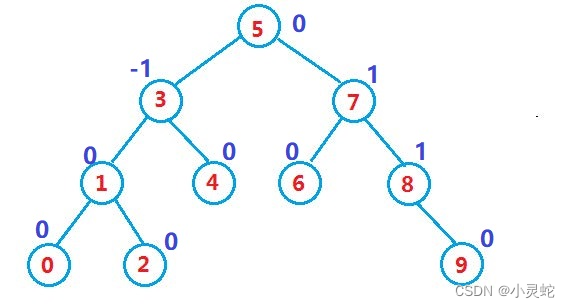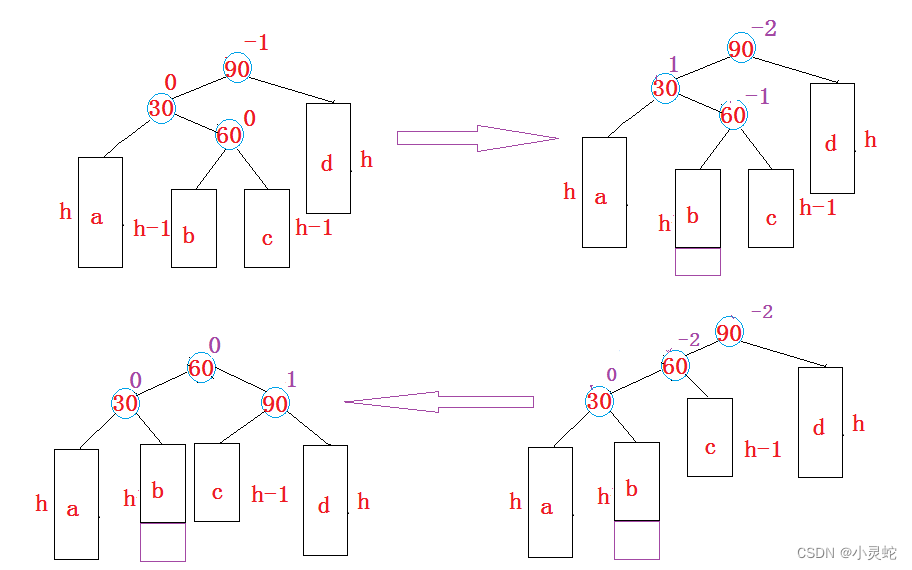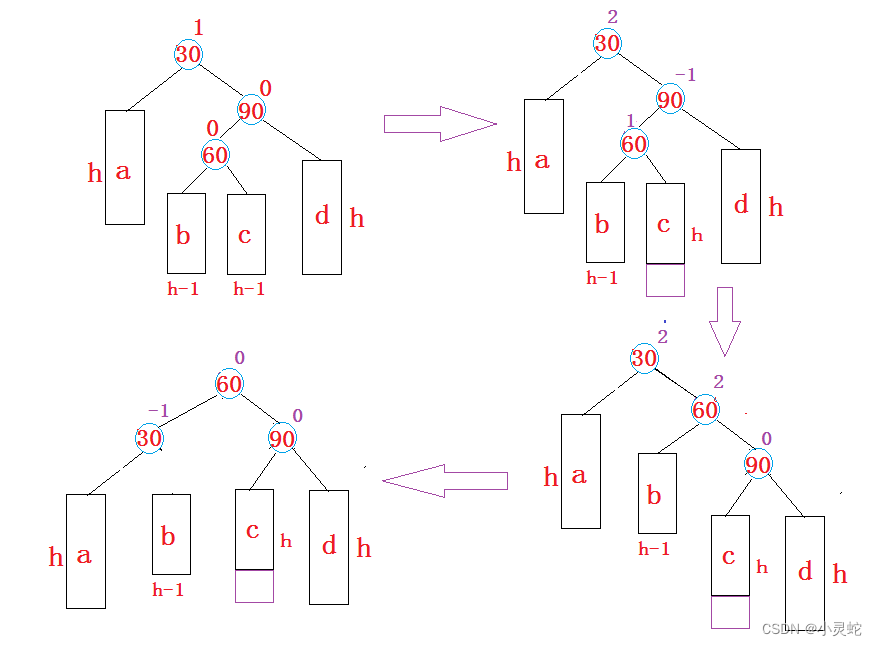目录
3.1.3.1 parent->_pf = 2 && cur->_pf = 1
3.1.3.2 parent->_pf = -2 && cur->_pf =- 1
3.1.3.3 parent->_pf = -2 && cur->_pf = 1
3.1.3.4 parent->_pf = 2 && cur->_pf = -1
一. AVL树的概念
我们上一篇博客讲了,二叉搜索树在极端情况下会退化为单支树的情况(具体可以看上一篇博客:http://t.csdnimg.cn/o7PiL)。那我们该如何解决这种问题呢?

诶,还真有这种方法,是由著名的两位俄罗斯的数学家G.M.Adelson-Velskii和E.M.Landis在1962年提出的。如果让左右子树的高度差的绝对值不超过1,那我们就可以避免这种单支树的情况。
那我们将具有以下特征的二叉搜索树叫做AVL树:
- 左右子树的高度差(这里简称平衡因子)的绝对值不超过1
- 左右子树都是AVL树

如果一棵树是高度平衡的,那它就是AVL树,如果这棵树有n个节点,那我们能把这棵树的高度维持在log2n,查找的时间复杂度可以维持在O(log2n)。
二. AVL树节点的定义
我们用代码来刻画这个定义:
template<class K,class V>
struct AVLTreeNode
{
AVLTreeNode<K, V>* _left;
AVLTreeNode<K, V>* _right;
AVLTreeNode<K, V>* _parent;
int _pf;//平衡因子
pair<K, V> _kv;
AVLTreeNode(const pair<K,V>& kv)
:_left(nullptr)
,_right(nullptr)
,_parent(nullptr)
,_pf(0)
,_kv(kv)
{}
};可以看见,我们引进了平衡因子这个变量,来显示左右子树的高度差。

特别说明:此处平衡因子是右边减去左边。
三. AVL树的基本操作
我们这里着重讲解AVL树的插入操作,其他操作与普通的二叉搜索树是一样的。
3.1 插入操作:
bool Insert(const pair<K, V>& kv)
{
if (_root == nullptr)
{
_root = new Node(kv);
return true;
}
Node* parent = nullptr;
Node* cur=_root;
while (cur)
{
if (cur->_kv.first > kv.first)
{
parent = cur;
cur = cur->_left;
}
else if (cur->_kv.first < kv.first)
{
parent = cur;
cur = cur->_right;
}
else
{
return false;
}
}
cur = new Node(kv);
if (parent->_kv.first>kv.first)
{
parent->_left = cur;
}
else if(parent->_kv.first < kv.first)
{
parent->_right = cur;
}
cur->_parent = parent;
while (parent)
{
if (cur == parent->_left)
{
parent->_pf--;
}
else if (cur == parent->_right)
{
parent->_pf++;
}
if (parent->_pf == 0)
{
break;
}
else if (parent->_pf == 1 || parent->_pf == -1)
{
cur = cur->_parent;
parent = parent->_parent;
}
else if (parent->_pf == 2 || parent->_pf == -2)
{
//旋转处理
if (parent->_pf == 2 && cur->_pf == 1)
{
RotaleL(parent);
}
else if (parent->_pf == -2 && cur->_pf ==- 1)
{
RotaleR(parent);
}
else if (parent->_pf == -2 && cur->_pf == 1)
{
RotaleLR(parent);
}
else
{
RotaleRL(parent);
}
break;
}
else
{
assert(false);
}
}
return true;
}我们依次来解析需要特殊处理的情况:
3.1.1 parent->_pf = 0
当父节点的平衡因子为0时,证明左右子树是平衡的,不需要再做处理,直接跳出循环。
if (parent->_pf == 0)
{
break;
}3.1.2 abs(parent->_pf) = 1
当父节点的平衡因子的绝对值为1时,证明此父节点下的子树是平衡的,但是,由于我们前面改变了父节点的平衡因子,可能导致父节点的祖宗节点不平衡,所以我们要向上迭代,再次进行判断。
else if (parent->_pf == 1 || parent->_pf == -1)
{
cur = cur->_parent;
parent = parent->_parent;
}3.1.3 abs(parent->_pf) = 2
当父节点的平衡因子绝对值为2时,我们为了保证树的平衡,需要进行一些旋转操作。此类情况比较复杂,又细分为以下几种情况:

3.1.3.1 parent->_pf = 2 && cur->_pf = 1
当父节点的平衡因子为2,而当前节点平衡因子为1时,是在当前节点是父节点的右子节点,并且插入节点是当前节点的右子节点发生的。

此时我们要进行左单旋:
if (parent->_pf == 2 && cur->_pf == 1)
{
RotaleL(parent);
}
void RotaleL(Node* parent)
{
totalSize++;
Node* subR = parent->_right;
Node* subRL = subR->_left;
parent->_right = subRL;
subR->_left = parent;
if (subRL)
{
subRL->_parent = parent;
}
Node* ppnode = parent->_parent;
parent->_parent = subR;
if (parent == _root)
{
_root = subR;
subR->_parent == nullptr;
}
else
{
if (parent == ppnode->_left)
{
ppnode->_left = subR;
}
else if (parent == ppnode->_right)
{
ppnode->_right = subR;
}
subR->_parent = ppnode;
}
parent->_pf = 0;
subR->_pf = 0;
}总结来说,此情况就是让当前节点的左子树变为父节点的右子树,而当前节点的左子树变为父节点,再改变当前节点和父节点的父节点指向并更新平衡因子即可。
3.1.3.2 parent->_pf = -2 && cur->_pf =- 1
当父节点的平衡因子为-2,而当前节点平衡因子为-1时,是在当前节点是父节点的左子节点,并且插入节点是当前节点的左子节点发生的。

此时我们要进行右单旋:
else if (parent->_pf == -2 && cur->_pf ==- 1)
{
RotaleR(parent);
}
void RotaleR(Node* parent)
{
totalSize++;
Node* subL = parent->_left;
Node* subLR = subL->_right;
parent->_left = subLR;
if (subLR)
{
subLR->_parent = parent;
}
subL->_right = parent;
Node* ppnode = parent->_parent;
parent->_parent = subL;
if (parent == _root)
{
_root=subL;
subL->_parent = nullptr;
}
else
{
if (ppnode->_left == parent)
{
ppnode->_left = subL;
}
else if (ppnode->_right == parent)
{
ppnode->_right = subL;
}
subL->_parent = ppnode;
}
subL->_pf = 0;
parent->_pf = 0;
}总结来说,此情况就是让当前节点的右子树变为父节点的左子树,而当前节点的右子树变为父节点,再改变当前节点和父节点的父节点指向并更新平衡因子即可。
3.1.3.3 parent->_pf = -2 && cur->_pf = 1
当父节点的平衡因子为-2,而当前节点平衡因子为1时,是在当前节点是父节点的左子节点,并且插入节点是当前节点的右子节点发生的。

此情况比较复杂,单一的旋转已经不能满足树的平衡了,我们此时要先左旋再右旋:
else if (parent->_pf == -2 && cur->_pf == 1)
{
RotaleLR(parent);
}
void RotaleLR(Node* parent)
{
totalSize++;
Node* subL = parent->_left;
Node* subLR = subL->_right;
int pf = subLR->_pf;
RotaleL(parent->_left);
RotaleR(parent);
if (pf == 1)
{
subLR->_pf = 0;
subL->_pf = -1;
parent->_pf = 0;
}
else if (pf == -1)
{
subL->_pf = 0;
subLR->_pf = 0;
parent->_pf = 1;
}
else if (pf == 0)
{
subL->_pf = 0;
subLR->_pf = 0;
parent->_pf = 0;
}
}总结来说,可以复用前面的左旋与右旋函数,但是与前面不同的是需要分情况处理平衡因子。
3.1.3.4 parent->_pf = 2 && cur->_pf = -1
当父节点的平衡因子为2,而当前节点平衡因子为-1时,是在当前节点是父节点的右子节点,并且插入节点是当前节点的左子节点发生的。

此情况同样单一的旋转已经不能满足树的平衡了,我们此时要先右旋再左旋:
else
{
RotaleRL(parent);
}
void RotaleRL(Node* parent)
{
totalSize++;
Node* subR = parent->_right;
Node* subRL = subR->_left;
int pf = subRL->_pf;
RotaleR(parent->_right);
RotaleL(parent);
if (pf == 1)
{
subRL->_pf = 0;
subR->_pf = 0;
parent->_pf = -1;
}
else if (pf == -1)
{
subR->_pf = 1;
subRL->_pf = 0;
parent->_pf = 0;
}
else if (pf == 0)
{
subR->_pf = 0;
subRL->_pf = 0;
parent->_pf = 0;
}
}总结来说,可以复用前面的右旋与左旋函数,但是与前面同样不同的是需要分情况处理平衡因子。
四. 总体代码
整合一下代码,如下:
template<class K,class V>
struct AVLTreeNode
{
AVLTreeNode<K, V>* _left;
AVLTreeNode<K, V>* _right;
AVLTreeNode<K, V>* _parent;
int _pf;//平衡因子
pair<K, V> _kv;
AVLTreeNode(const pair<K,V>& kv)
:_left(nullptr)
,_right(nullptr)
,_parent(nullptr)
,_pf(0)
,_kv(kv)
{}
};
template<class K, class V>
class AVLTree
{
typedef AVLTreeNode<K, V> Node;
public:
bool Insert(const pair<K, V>& kv)
{
if (_root == nullptr)
{
_root = new Node(kv);
return true;
}
Node* parent = nullptr;
Node* cur=_root;
while (cur)
{
if (cur->_kv.first > kv.first)
{
parent = cur;
cur = cur->_left;
}
else if (cur->_kv.first < kv.first)
{
parent = cur;
cur = cur->_right;
}
else
{
return false;
}
}
cur = new Node(kv);
if (parent->_kv.first>kv.first)
{
parent->_left = cur;
}
else if(parent->_kv.first < kv.first)
{
parent->_right = cur;
}
cur->_parent = parent;
while (parent)
{
if (cur == parent->_left)
{
parent->_pf--;
}
else if (cur == parent->_right)
{
parent->_pf++;
}
if (parent->_pf == 0)
{
break;
}
else if (parent->_pf == 1 || parent->_pf == -1)
{
cur = cur->_parent;
parent = parent->_parent;
}
else if (parent->_pf == 2 || parent->_pf == -2)
{
//旋转处理
if (parent->_pf == 2 && cur->_pf == 1)
{
RotaleL(parent);
}
else if (parent->_pf == -2 && cur->_pf ==- 1)
{
RotaleR(parent);
}
else if (parent->_pf == -2 && cur->_pf == 1)
{
RotaleLR(parent);
}
else
{
RotaleRL(parent);
}
break;
}
else
{
assert(false);
}
}
return true;
}
void RotaleL(Node* parent)
{
totalSize++;
Node* subR = parent->_right;
Node* subRL = subR->_left;
parent->_right = subRL;
subR->_left = parent;
if (subRL)
{
subRL->_parent = parent;
}
Node* ppnode = parent->_parent;
parent->_parent = subR;
if (parent == _root)
{
_root = subR;
subR->_parent == nullptr;
}
else
{
if (parent == ppnode->_left)
{
ppnode->_left = subR;
}
else if (parent == ppnode->_right)
{
ppnode->_right = subR;
}
subR->_parent = ppnode;
}
parent->_pf = 0;
subR->_pf = 0;
}
void RotaleR(Node* parent)
{
totalSize++;
Node* subL = parent->_left;
Node* subLR = subL->_right;
parent->_left = subLR;
if (subLR)
{
subLR->_parent = parent;
}
subL->_right = parent;
Node* ppnode = parent->_parent;
parent->_parent = subL;
if (parent == _root)
{
_root=subL;
subL->_parent = nullptr;
}
else
{
if (ppnode->_left == parent)
{
ppnode->_left = subL;
}
else if (ppnode->_right == parent)
{
ppnode->_right = subL;
}
subL->_parent = ppnode;
}
subL->_pf = 0;
parent->_pf = 0;
}
void RotaleLR(Node* parent)
{
totalSize++;
Node* subL = parent->_left;
Node* subLR = subL->_right;
int pf = subLR->_pf;
RotaleL(parent->_left);
RotaleR(parent);
if (pf == 1)
{
subLR->_pf = 0;
subL->_pf = -1;
parent->_pf = 0;
}
else if (pf == -1)
{
subL->_pf = 0;
subLR->_pf = 0;
parent->_pf = 1;
}
else if (pf == 0)
{
subL->_pf = 0;
subLR->_pf = 0;
parent->_pf = 0;
}
}
void RotaleRL(Node* parent)
{
totalSize++;
Node* subR = parent->_right;
Node* subRL = subR->_left;
int pf = subRL->_pf;
RotaleR(parent->_right);
RotaleL(parent);
if (pf == 1)
{
subRL->_pf = 0;
subR->_pf = 0;
parent->_pf = -1;
}
else if (pf == -1)
{
subR->_pf = 1;
subRL->_pf = 0;
parent->_pf = 0;
}
else if (pf == 0)
{
subR->_pf = 0;
subRL->_pf = 0;
parent->_pf = 0;
}
}
void _Inorder(Node* root)
{
if (root == nullptr)
{
return;
}
_Inorder(root->_left);
cout << root->_kv.first << "[" << root->_pf << "]" << endl;
_Inorder(root->_right);
}
void Inorder()
{
_Inorder(_root);
}
int _Height(Node* root)
{
if (root == nullptr)
{
return 0;
}
int leftheight = _Height(root->_left);
int rightheight = _Height(root->_right);
return leftheight > rightheight ? leftheight + 1 : rightheight + 1;
}
int Height()
{
return _Height(_root);
}
//初始版本
/*bool _IsBalance(Node* root)
{
if (root == nullptr)
{
return true;
}
int leftheight = _Height(root->_left);
int rightheight = _Height(root->_right);
if (abs(leftheight - rightheight) >= 2)
{
cout << root->_kv.first << "不平衡" << endl;
return false;
}
else if ((rightheight - leftheight) != root->_pf)
{
cout << root->_kv.first << "平衡因子异常" << endl;
return false;
}
return _IsBalance(root->_left) && _IsBalance(root->_right);
}*/
bool _IsBalance(Node* root,int& height)
{
if (root == nullptr)
{
height = 0;
return true;
}
int leftheight = 0, rightheight = 0;
if (!_IsBalance(root->_left, leftheight)
||!_IsBalance(root->_right, rightheight))
{
return false;
}
if (abs(rightheight - leftheight) >= 2)
{
cout << root->_kv.first << "不平衡" << endl;
return false;
}
else if ((rightheight - leftheight) != root->_pf)
{
cout << root->_kv.first << "平衡因子异常" << endl;
return false;
}
height = leftheight > rightheight ? leftright + 1 : rightheight + 1;
return true;
}
bool IsBalance()
{
int height = 0;
return _IsBalance(_root,height);
}
size_t _size(Node* root)
{
if (root == nullptr)
{
return 0;
}
return _size(root->_left) + _size(root->_right) + 1;
}
Node* Find(const K& key)
{
Node* cur = _root;
while (cur)
{
if (cur->_kv.first > key)
{
cur = cur->_left;
}
else if (cur->_kv.first < key)
{
cur = cur->_right;
}
else
{
return cur;
}
}
return nullptr;
}
size_t size()
{
return _size(_root);
}
int GettotalSize()
{
return totalSize;
}
private:
Node* _root = nullptr;
int totalSize = 0;
};总结
好了,到这里今天的知识就讲完了,大家有错误一点要在评论指出,我怕我一人搁这瞎bb,没人告诉我错误就寄了。
祝大家越来越好,不用关注我(疯狂暗示)























 2207
2207











 被折叠的 条评论
为什么被折叠?
被折叠的 条评论
为什么被折叠?








